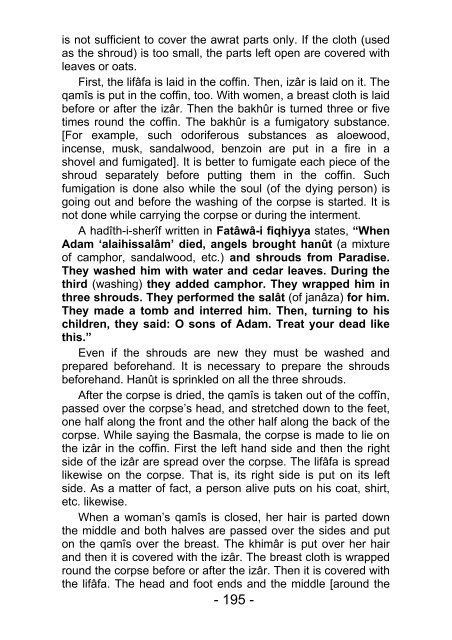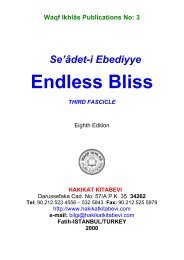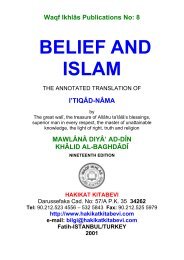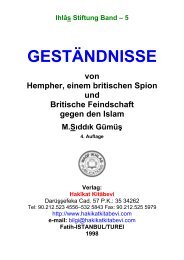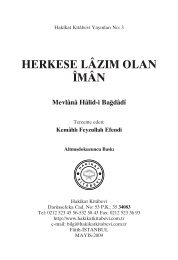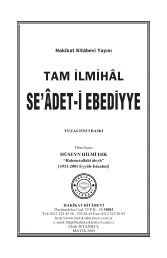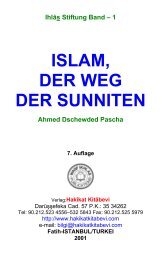5-Endless Bliss Fifth Fascicle - Hakikat Kitabevi
5-Endless Bliss Fifth Fascicle - Hakikat Kitabevi
5-Endless Bliss Fifth Fascicle - Hakikat Kitabevi
You also want an ePaper? Increase the reach of your titles
YUMPU automatically turns print PDFs into web optimized ePapers that Google loves.
is not sufficient to cover the awrat parts only. If the cloth (used<br />
as the shroud) is too small, the parts left open are covered with<br />
leaves or oats.<br />
First, the lifâfa is laid in the coffin. Then, izâr is laid on it. The<br />
qamîs is put in the coffin, too. With women, a breast cloth is laid<br />
before or after the izâr. Then the bakhûr is turned three or five<br />
times round the coffin. The bakhûr is a fumigatory substance.<br />
[For example, such odoriferous substances as aloewood,<br />
incense, musk, sandalwood, benzoin are put in a fire in a<br />
shovel and fumigated]. It is better to fumigate each piece of the<br />
shroud separately before putting them in the coffin. Such<br />
fumigation is done also while the soul (of the dying person) is<br />
going out and before the washing of the corpse is started. It is<br />
not done while carrying the corpse or during the interment.<br />
A hadîth-i-sherîf written in Fatâwâ-i fiqhiyya states, “When<br />
Adam ‘alaihissalâm’ died, angels brought hanût (a mixture<br />
of camphor, sandalwood, etc.) and shrouds from Paradise.<br />
They washed him with water and cedar leaves. During the<br />
third (washing) they added camphor. They wrapped him in<br />
three shrouds. They performed the salât (of janâza) for him.<br />
They made a tomb and interred him. Then, turning to his<br />
children, they said: O sons of Adam. Treat your dead like<br />
this.”<br />
Even if the shrouds are new they must be washed and<br />
prepared beforehand. It is necessary to prepare the shrouds<br />
beforehand. Hanût is sprinkled on all the three shrouds.<br />
After the corpse is dried, the qamîs is taken out of the coffîn,<br />
passed over the corpse’s head, and stretched down to the feet,<br />
one half along the front and the other half along the back of the<br />
corpse. While saying the Basmala, the corpse is made to lie on<br />
the izâr in the coffin. First the left hand side and then the right<br />
side of the izâr are spread over the corpse. The lifâfa is spread<br />
likewise on the corpse. That is, its right side is put on its left<br />
side. As a matter of fact, a person alive puts on his coat, shirt,<br />
etc. likewise.<br />
When a woman’s qamîs is closed, her hair is parted down<br />
the middle and both halves are passed over the sides and put<br />
on the qamîs over the breast. The khimâr is put over her hair<br />
and then it is covered with the izâr. The breast cloth is wrapped<br />
round the corpse before or after the izâr. Then it is covered with<br />
the lifâfa. The head and foot ends and the middle [around the<br />
- 195 -


